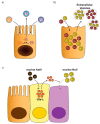Enteric Viral Co-Infections: Pathogenesis and Perspective
- PMID: 32824880
- PMCID: PMC7472086
- DOI: 10.3390/v12080904
Enteric Viral Co-Infections: Pathogenesis and Perspective
Abstract
Enteric viral co-infections, infections involving more than one virus, have been reported for a diverse group of etiological agents, including rotavirus, norovirus, astrovirus, adenovirus, and enteroviruses. These pathogens are causative agents for acute gastroenteritis and diarrheal disease in immunocompetent and immunocompromised individuals of all ages globally. Despite virus-virus co-infection events in the intestine being increasingly detected, little is known about their impact on disease outcomes or human health. Here, we review what is currently known about the clinical prevalence of virus-virus co-infections and how co-infections may influence vaccine responses. While experimental investigations into enteric virus co-infections have been limited, we highlight in vivo and in vitro models with exciting potential to investigate viral co-infections. Many features of virus-virus co-infection mechanisms in the intestine remain unclear, and further research will be critical.
Keywords: co-infection; co-infection models; enteric virus; viral pathogenesis.
Conflict of interest statement
The authors declare no conflict of interest. The funders had no role in the design of the study; in the collection, analyses, or interpretation of data; in the writing of the manuscript, or in the decision to publish the results.
Figures


Similar articles
-
Fecal Respiratory Viruses in Acute Viral Respiratory Infection and Nasopharyngeal Diarrheal Viruses in Acute Viral Gastroenteritis: Clinical Impact of Ectopic Viruses Is Questionable.J Microbiol Biotechnol. 2018 Mar 28;28(3):465-472. doi: 10.4014/jmb.1707.07058. J Microbiol Biotechnol. 2018. PMID: 29212291
-
Enteric viruses in HIV-1 seropositive and HIV-1 seronegative children with diarrheal diseases in Brazil.PLoS One. 2017 Aug 30;12(8):e0183196. doi: 10.1371/journal.pone.0183196. eCollection 2017. PLoS One. 2017. PMID: 28854225 Free PMC article.
-
Prevalence and Genetic Diversity of Enteric Viruses in Children with Diarrhea in Ouagadougou, Burkina Faso.PLoS One. 2016 Apr 19;11(4):e0153652. doi: 10.1371/journal.pone.0153652. eCollection 2016. PLoS One. 2016. PMID: 27092779 Free PMC article.
-
Experimental Methods to Study the Pathogenesis of Human Enteric RNA Viruses.Viruses. 2021 May 25;13(6):975. doi: 10.3390/v13060975. Viruses. 2021. PMID: 34070283 Free PMC article. Review.
-
Microbial agents associated with waterborne diseases.Crit Rev Microbiol. 2002;28(4):371-409. doi: 10.1080/1040-840291046768. Crit Rev Microbiol. 2002. PMID: 12546197 Review.
Cited by
-
Enteric virome negatively affects seroconversion following oral rotavirus vaccination in a longitudinally sampled cohort of Ghanaian infants.Cell Host Microbe. 2022 Jan 12;30(1):110-123.e5. doi: 10.1016/j.chom.2021.12.002. Epub 2021 Dec 20. Cell Host Microbe. 2022. PMID: 34932985 Free PMC article.
-
Candida albicans-enteric viral interactions-The prostaglandin E2 connection and host immune responses.iScience. 2022 Dec 24;26(1):105870. doi: 10.1016/j.isci.2022.105870. eCollection 2023 Jan 20. iScience. 2022. PMID: 36647379 Free PMC article. Review.
-
Enterovirus genotype diversity with emergence of coxsackievirus A2 circulating in pediatric patients with acute gastroenteritis in Thailand, 2019-2022.Front Microbiol. 2024 Jun 3;15:1414698. doi: 10.3389/fmicb.2024.1414698. eCollection 2024. Front Microbiol. 2024. PMID: 38887714 Free PMC article.
-
Prevalence and genotype distribution of norovirus in Ningxia Hui Autonomous Region, China, from 2011 to 2022.Virol J. 2024 Sep 27;21(1):232. doi: 10.1186/s12985-024-02498-5. Virol J. 2024. PMID: 39334155 Free PMC article.
-
Liver Transaminases in Pediatric Adenovirus Infection-A Five-Year Study in Two Major Reference Centers from Romania.Microorganisms. 2023 Jan 24;11(2):302. doi: 10.3390/microorganisms11020302. Microorganisms. 2023. PMID: 36838267 Free PMC article.
References
-
- Mills J.A.P., Liu J., Rogawski E.T., Kabir F., Lertsethtakarn P., Siguas M., Investigators M.-E.N. Use of quantitative molecular diagnostic methods to assess the aetiology, burden, and clinical characteristics of diarrhoea in children in low-resource settings: A reanalysis of the MAL-ED cohort study. Lancet Glob. Health. 2018;6:e1309–e1318. doi: 10.1016/S2214-109X(18)30349-8. - DOI - PMC - PubMed
Publication types
MeSH terms
Grants and funding
LinkOut - more resources
Full Text Sources
Other Literature Sources
Medical

